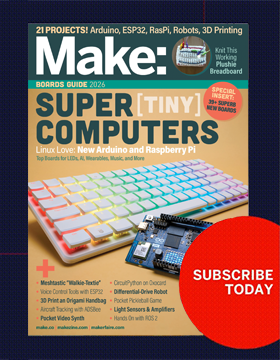Skip to content

The ever-growing variety of 3D printing filaments is amazing — we can now print in strong, flexible, glowing, and dissolvable plastics — but sometimes plastic isn’t the right material for the job. Sometimes, you just need metal!
Although the big boys in the industrial world can directly 3D print metal parts with laser sintering machines, this technology hasn’t yet reached consumers. However, you can make your own metal parts at home with the help of your 3D printer and these easy-to-learn metal casting techniques.

The PiLarm is a an all-in-one alarm system that uses a Raspberry Pi, motion sensor, and camera. Pictures of intruders are tweeted and emailed before the revolving light, siren, and computer voice warn the intruder away.

Continuing the tradition of homemade resonator guitars, follow along as we build a License Plate Guitar. A discarded vehicle's license plate will serve as our metal resonator top. This will be mounted atop a soundbox custom-fitted for the license plate, and the build completed with a hand-wound pickup, bridge, nut, and neck. The electronics are simple, the woodworking is fun, and the project sounds great!

Build a Filabot Wee and make all the plastic you can print, for a fraction of the retail price.

Cast metal right on your desktop!

No security system is complete without lasers.

Print your own articulating action-hero robot model.

Want to upgrade or customize your 3D printer? Build this robust extruder using a handful of tools, one online parts order, and a trip to the auto-parts store. For a heater, it uses a $10 glow plug from a diesel engine — and it performs as well as commercially available extruders.

Use this rig with a Kinect sensor to make full-body scans of your guests for 3D printing.

Build a heavy duty turntable for use with your Scan-O-Tron 3000.

You can show off your mobile photos and your phone hack savvy by turning your smartphone into an inexpensive projector.

It’s alive! Hack your My Keepon toy into a low-cost animatronic puppet with many of the same functions as Keepon Pro. We'll show you how to connect an Arduino to My Keepon’s electronics, so you can control it using just about any sensors, devices, and interfaces you can imagine, wired or wireless.
When you buy through links on our site, we may earn an affiliate commission.
Cookie Settings















